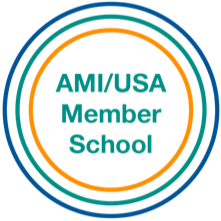Primary
3 - 6 years

Our Primary Program is structured upon the Montessori Method of education, based on Dr. Maria Montessori’s research using a carefully prepared environment to teach children in mixed age classrooms.
Program Overview
Offering a variety of activities, as well as a great deal of movement, the setting is equipped with child-sized furnishings to foster a sense of independence and, with scientifically designed materials that impart all the basic concepts of language and math.
Lessons in various subjects are given on an individual basis and follow each child’s developmental readiness. Children are able to work freely in the classroom, with the teacher as a guide to facilitate learning appropriate for each child to be successful.
Typical Day
During a typical day, a three-year-old may be scrubbing a table while a four-year-old nearby composes words and phrases with the moveable alphabet. Meanwhile, a five-year-old performs multiplication using a specially designed set of beads. Although much of the work at this stage of development is done individually, children often enjoy working at an activity with friends.
When able to choose a lesson that responds to a child’s internal need, the child becomes self-directed. Allowing them to work independently without interruption, they’re able to process the lesson in their own way, at their own pace, to completion. Enhancing this process is the design of the Montessori classroom, which contains self-correcting material that promotes self-esteem, empowering children to discover the solutions to lessons in their own time.
The Practical Life Area
Familiar objects found in their own homes attract children to the Practical Life area in the classroom. Through activities involving self-care and care of the classroom environment, children develop concentration, coordination, focus, order, and independence.
Lessons are arranged from left to right on the work tray to begin training the eyes for reading. Each child learns to carry and use the materials to complete a task following an orderly process, with each lesson progressing in difficulty. A child may choose any piece of work in the class that he has had a lesson in to promote self-direction, self-motivation, and success.
“I have two daughters who currently attend this school. One when she was just 10 months old and the other at 3. They have been here 4 years now. I cannot stay enough of how amazing this school and staff are. They are so caring, loving, attentive yet professional. My daughters love their school and cannot wait for the weekend to be over to return. This school is a GEM! Both girls have grown to be mature, caring and smart girls. My oldest was reading and doing first grade workbooks before entering "Kindergarten" level. Very impressive. I know this would not have been achieved at a regular preschool. I know when she enters 1st grade she will be more than ready and advanced. Everywhere I go, I am given compliments on how smart, mature and well behaved they are. ”
-
Rebecca F.
The Language Area
The Montessori language area isolates elements of language—such as phonetic sounds—offering it to children as a key in decoding the mystery of reading. Using multi-sensory, tactile equipment, the child is able to use touch, sight, and sound to learn the lessons in the literacy area.
Lessons start with concrete pre-reading materials and proceed to the more abstract concept of reading. Sandpaper letters are felt while the sound of each letter is repeated. Eventually, the child combines these letters/sounds with the Moveable Alphabet to form phonetic words. The child progresses through the tracing and recognition of letters to beginning writing in formal exercises.
Language presentations progress as the child gains fluency in reading to include the first experiences of parts of speech and functions of words.
The Math Area
The Montessori Mathematics area can be broken down into precise areas. The first is numbers one through ten. Similar to the Language area, sandpaper numbers are used as the child learns to recognize the numbers and acquires the ability to associate the quantity with the written symbol.
The decimal system is then introduced using concrete materials, which allow the child to see, feel, add, multiply, subtract and divide up to 9,999. Squaring and cubing chains are introduced and the child delights in laying out the extremely long ten chain. By working with concrete materials, the child develops a solid basis for understanding the decimal system, geometric forms, and basic arithmetic operations.
The Sensorial Area
Each Sensorial material in this area isolates one defining concept such as color, weight, shape, texture, sound, and smell. The materials are self- correcting and allow the child to categorize, isolate and distinguish between the qualities they’re learning.
Designed to sharpen the child’s five senses, these exercises help them to understand sensory impressions.

